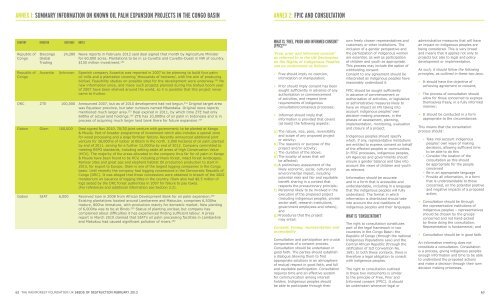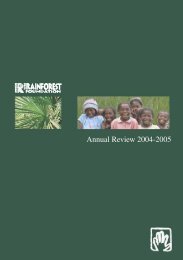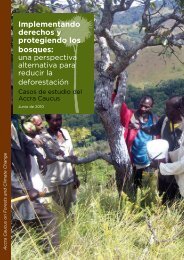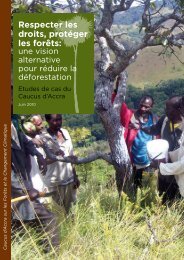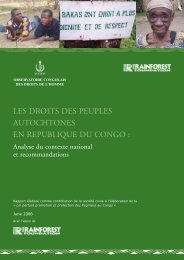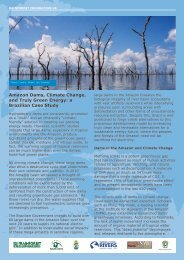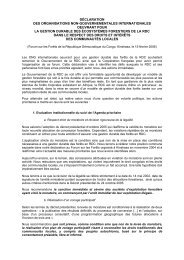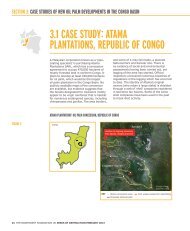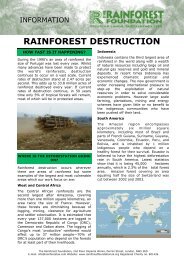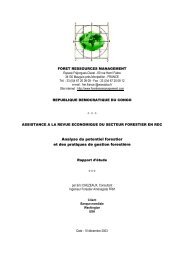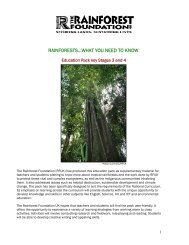Seeds of Destruction - Rainforest Foundation UK
Seeds of Destruction - Rainforest Foundation UK
Seeds of Destruction - Rainforest Foundation UK
You also want an ePaper? Increase the reach of your titles
YUMPU automatically turns print PDFs into web optimized ePapers that Google loves.
ANNEX 1: SUMMARY INFORMATION ON KNOWN OIL PALM EXPANSION PROJECTS IN THE CONGO BASIN<br />
ANNEX 2: FPIC AND CONSULTATION<br />
COUNTRY INVESTOR HECTARES NOTES<br />
Republic <strong>of</strong><br />
Congo<br />
Republic <strong>of</strong><br />
Congo<br />
Biocongo<br />
Global<br />
Trading<br />
24,280 News reports in February 2012 said deal signed that month by Agriculture Minister<br />
for 60,000 acres. Plantations to be in La Cuvette and Cuvette-Ouest in NW <strong>of</strong> country.<br />
$150 million investment. 252<br />
Aurantia Unknown Spanish company Aurantia was reported in 2007 to be planning to build four palm<br />
oil mills and a plantation covering ‘thousands <strong>of</strong> hectares’, with the aim <strong>of</strong> producing<br />
bi<strong>of</strong>uel. Feasibility studies on possible sites for the development were underway. 253 No<br />
new information since, and many such projects planned during the bi<strong>of</strong>uel boom year<br />
<strong>of</strong> 2007 have been shelved around the world, so it is possible that this project never<br />
came to fruition.<br />
DRC ZTE 100,000 Announced 2007, but as <strong>of</strong> 2010 development had not begun. 254 Original target area<br />
was Equateur province, but later rumours named Mbandaka. Original news reports<br />
mentioned much larger area. 255 Deal expired in 2011, by which time ZTE had only<br />
600ha <strong>of</strong> actual land holdings. 256 ZTE has 10,000ha <strong>of</strong> oil palm in Indonesia and is in<br />
process <strong>of</strong> acquiring much larger land bank there for future expansion. 257<br />
Gabon Olam 100,000 Deal signed Nov 2010. 70/30 joint venture with government; to be planted at Kango<br />
& Mouila. Part <strong>of</strong> broader programme <strong>of</strong> investment which also includes a special zone<br />
for wood processing and a large fertiliser factory. Recently announced additional joint<br />
venture for 28,000ha <strong>of</strong> rubber at Bitam in the north. 2,000 hectares <strong>of</strong> oil palm planted<br />
by end <strong>of</strong> 2011, aiming for a further 12,000ha by end <strong>of</strong> 2012. Company committed to<br />
meeting RSPO standards, including setting aside all areas <strong>of</strong> High Conservation Value<br />
(HCV). The majority <strong>of</strong> the areas allocated to the company thus far for oil palm in Kango<br />
& Mouila have been found to be HCV, including primary forest, intact forest landscapes,<br />
Ramsar sites and great ape and elephant habitat Oil production production to start in<br />
2015, for export to Europe. Olam is one <strong>of</strong> the largest logging companies in the Congo<br />
basin. Until recently the company had logging concessions in the Democratic Republic <strong>of</strong><br />
Congo (DRC). It was alleged that these concessions were obtained in breach <strong>of</strong> the 2002<br />
moratorium on issuance <strong>of</strong> logging titles in the country. Olam also had $0.5 million <strong>of</strong><br />
logs seized by the DRC forest authorities in 2007 for failure to pay taxes.<br />
(For references and additional information see Section 3.2).<br />
Gabon SIAT 6,000 Received loan in 2008 from African Development Bank for oil palm expansion. 258<br />
Existing plantations located around Lambarene and Makouke, comprises 6,500ha<br />
mature, 800ha immature, with production mainly for domestic market. New planting<br />
<strong>of</strong> 6,000ha was to be at Bindo. 259 Status <strong>of</strong> planting unclear, but company has<br />
complained about difficulties it has experienced finding sufficient labour. A press<br />
report in March 2010 claimed that SIAT’s oil palm processing facilities in Lambaréné<br />
and Makokou had caused significant pollution <strong>of</strong> rivers. 260<br />
WHAT IS ‘FREE, PRIOR AND INFORMED CONSENT’<br />
(FPIC)? 261<br />
‘Free, prior and informed consent’<br />
as referred to in the UN Declaration<br />
on the Rights <strong>of</strong> Indigenous Peoples<br />
can be understood as follows:<br />
• Free should imply no coercion,<br />
intimidation or manipulation;<br />
• Prior should imply consent has been<br />
sought sufficiently in advance <strong>of</strong> any<br />
authorisation or commencement<br />
<strong>of</strong> activities, and respect time<br />
requirements <strong>of</strong> indigenous<br />
consultation/consensus processes;<br />
• Informed should imply that<br />
information is provided that covers<br />
(at least) the following aspects:<br />
a) The nature, size, pace, reversibility<br />
and scope <strong>of</strong> any proposed project<br />
or activity;<br />
b) The reason/s or purpose <strong>of</strong> the<br />
project and/or activity;<br />
c) The duration <strong>of</strong> the above;<br />
d) The locality <strong>of</strong> areas that will<br />
be affected;<br />
e) A preliminary assessment <strong>of</strong> the<br />
likely economic, social, cultural and<br />
environmental impact, including<br />
potential risks and fair and equitable<br />
benefit sharing in a context that<br />
respects the precautionary principle;<br />
f) Personnel likely to be involved in the<br />
execution <strong>of</strong> the proposed project<br />
(including indigenous peoples, private<br />
sector staff, research institutions,<br />
government employees and others);<br />
and<br />
g) Procedures that the project<br />
may entail.<br />
Consent, timing, representation and<br />
accessibility<br />
Consultation and participation are crucial<br />
components <strong>of</strong> a consent process.<br />
Consultation should be undertaken in<br />
good faith. The parties should establish<br />
a dialogue allowing them to find<br />
appropriate solutions in an atmosphere<br />
<strong>of</strong> mutual respect in good faith, and full<br />
and equitable participation. Consultation<br />
requires time and an effective system<br />
for communication among interest<br />
holders. Indigenous peoples should<br />
be able to participate through their<br />
own freely chosen representatives and<br />
customary or other institutions. The<br />
inclusion <strong>of</strong> a gender perspective and<br />
the participation <strong>of</strong> indigenous women<br />
are essential, as well as participation<br />
<strong>of</strong> children and youth as appropriate.<br />
This process may include the option <strong>of</strong><br />
withholding consent.<br />
Consent to any agreement should be<br />
interpreted as indigenous peoples have<br />
reasonably understood it.<br />
FPIC should be sought sufficiently<br />
in advance <strong>of</strong> commencement or<br />
authorization <strong>of</strong> activities, or legislative<br />
or administrative measures likely to<br />
have an impact on IPs taking into<br />
account indigenous peoples’ own<br />
decision-making processes, in the<br />
phases <strong>of</strong> assessment, planning,<br />
implementation, monitoring, evaluation<br />
and closure <strong>of</strong> a project.<br />
Indigenous peoples should specify<br />
which, if any, representative institutions<br />
are entitled to express consent on behalf<br />
<strong>of</strong> the affected peoples or communities.<br />
In FPIC processes, indigenous peoples,<br />
UN Agencies and governments should<br />
ensure a gender balance and take into<br />
account the views <strong>of</strong> children and youth<br />
as relevant.<br />
Information should be accurate<br />
and in a form that is accessible and<br />
understandable, including in a language<br />
that the indigenous peoples will fully<br />
understand. The format in which<br />
information is distributed should take<br />
into account the oral traditions <strong>of</strong><br />
indigenous peoples and their languages.<br />
WHAT IS ‘CONSULTATION’?<br />
The right to consultation constitutes<br />
part <strong>of</strong> the legal framework in two<br />
countries in the Congo Basin: the<br />
Republic <strong>of</strong> Congo (through the national<br />
Indigenous Populations Law) and the<br />
Central African Republic (through the<br />
ratification <strong>of</strong> ILO Convention No.<br />
169). In both these contexts, there is<br />
therefore a legal obligation to consult<br />
with indigenous peoples.<br />
The right to consultation outlined<br />
in these two instruments is similar<br />
to the principle <strong>of</strong> Free, Prior and<br />
Informed consent (FPIC). It should<br />
be undertaken whenever legal or<br />
administrative measures that will have<br />
an impact on indigenous peoples are<br />
being considered. This is very broad<br />
and means that it applies not only to<br />
projects but also to legal and policy<br />
development or implementation.<br />
As such, it should follow the following<br />
principles, as outlined in these two laws.<br />
• It should have the objective <strong>of</strong><br />
achieving agreement or consent;<br />
• The process <strong>of</strong> consultation should<br />
allow for those concerned to express<br />
themselves freely, in a fully informed<br />
manner;<br />
• It should be conducted in a form<br />
appropriate to the circumstances.<br />
This means that the consultation<br />
process should:<br />
- Take into account indigenous<br />
peoples’ own ways <strong>of</strong> making<br />
decisions, allowing sufficient time<br />
to be able to do this<br />
- Consider the location <strong>of</strong> the<br />
consultation as this should<br />
be appropriate for the people<br />
concerned<br />
- Be in an appropriate language<br />
- Provide all information, in a form<br />
that is understandable to those<br />
concerned, on the potential positive<br />
and negative impacts <strong>of</strong> a proposed<br />
action;<br />
• Consultation should be through<br />
the representative institutions <strong>of</strong><br />
indigenous peoples – representatives<br />
should be chosen by the groups<br />
concerned and not hand-picked<br />
by those doing the consultation.<br />
Representation is fundamental; and<br />
• Consultation should be in good faith.<br />
An information meeting does not<br />
constitute a consultation. Consultation<br />
is a process, giving indigenous peoples<br />
enough information and time to be able<br />
to understand the proposed actions<br />
and make a decision through their own<br />
decision making processes.<br />
62 THE RAINFOREST FOUNDATION <strong>UK</strong> SEEDS OF DESTRUCTION FEBRUARY 2013 63


